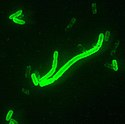Plicní mor

Plicní mor nebo pneumonický mor je jedna z forem moru, smrtelné nemoci způsobené bakterií Yersinia pestis.[1]
Tato forma moru se přenáší kapénkovou infekcí přímo z člověka na člověka a je mnohem nebezpečnější než ostatní dvě, septická i dýmějová. Plicní forma probíhá jako těžký zápal plic s velmi vysokou smrtností. Působí velice rychle a neléčena má velice vysokou smrtnost (až přes 90 %, podle některých zdrojů 100 %[2]).
Infekce
Přenos
- Nejprve se morová nákaza šíří zprostředkovaně přenašeči, proto se i plicní forma vyskytuje až druhotně jako pozdní projev nemoci po lymfatickém zánětu, spolu se septickou formou.
- Plicní mor se může šířit přímo z člověka na člověka aerosolem: Primární plicní nákaza se šíří kapénkově, plíce pak jsou prvním místem infekce. Plicní formy se tedy vyskytují až jako projev síly epidemie.
Projevy
- Horečka
- Pocity chladu
- Dušnost
- Kašel
- Bolest hrudníku
- Obtížné dýchání
- Hemoptýza
- Letargie
- Hypotenze
- Šok oběhového systému
- Symptomy bubonického moru, nemusí se však vyskytovat vždy[3]
Stejně jako v ostatních typů moru i zde po odeznění inkubační doby dochází k náhlému nastoupení kašle, vysokých teplot a úbytku sil. Od této chvíle infekce nabývá na vážnosti a kvůli vysoké rychlosti replikace způsobuje léčený mor úmrtí zhruba v 50 % případů, neléčený téměř vždy.[4]
Odkazy
Reference
V tomto článku byl použit překlad textu z článku Pneumonic plague na anglické Wikipedii.
- ↑ (anglicky)ZOONOTIC BACTERIAL DISEASES (020-027), 020 Plague (Includes: infection by Yersinia [Pasteurella] pestis), icd9cm.chrisendres.com
- ↑ (anglicky)Plague, PDF, Iowa State University, 2004, cfsph.iastate.edu
- ↑ (anglicky)Jameson, J. N. St C.; Dennis L. Kasper; Harrison, Tinsley Randolph; Braunwald, Eugene; Fauci, Anthony S.; Hauser, Stephen L; Longo, Dan L. Harrison's principles of internal medicine. New York: McGraw-Hill Medical Publishing Division, 2005. ISBN 0-07-140235-7.
- ↑ (anglicky)Riedel S. Plague: from natural disease to bio-terrorism. Proc (Bayl Univ Med Cent). 2005, roč. 18, čís. 2, s. 116–24. PMID 16200159.
Související články
Externí odkazy
 Obrázky, zvuky či videa k tématu plicní mor na Wikimedia Commons
Obrázky, zvuky či videa k tématu plicní mor na Wikimedia Commons - (anglicky)Facts about Pneumonic Plague, bt.cdc.gov, Centers for Disease Control and Prevention

Přečtěte si prosím pokyny pro využití článků o zdravotnictví.
Média použitá na této stránce
Star of life, blue version. Represents the Rod of Asclepius, with a snake around it, on a 6-branch star shaped as the cross of 3 thick 3:1 rectangles.
Design:
The logo is basically unicolor, most often a slate or medium blue, but this design uses a slightly lighter shade of blue for the outer outline of the cross, and the outlines of the rod and of the snake. The background is transparent (but the star includes a small inner plain white outline). This makes this image usable and visible on any background, including blue. The light shade of color for the outlines makes the form more visible at smaller resolutions, so that the image can easily be used as an icon.
This SVG file was manually created to specify alignments, to use only integers at the core 192x192 size, to get smooth curves on connection points (without any angle), to make a perfect logo centered in a exact square, to use a more precise geometry for the star and to use slate blue color with slightly lighter outlines on the cross, the rod and snake.
Finally, the SVG file is clean and contains no unnecessary XML elements or attributes, CSS styles or transforms that are usually added silently by common SVG editors (like Sodipodi or Inkscape) and that just pollute the final document, so it just needs the core SVG elements for the rendering. This is why its file size is so small.Yersinia pestis, Direct Fluorescent Antibody Stain (DFA), 200x Magnification. CDC 2057 - US Government public domain image

